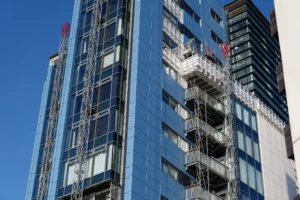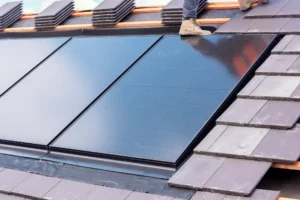The façade — once considered just an architectural feature — has become one of the most critical components in achieving net-zero buildings. As construction moves toward energy efficiency, sustainability, and safety, façades now sit at the intersection of design, technology, and environmental performance. This evolution is driving a new generation of jobs and skills — and creating fertile ground for career growth and innovation across the built environment.
1) The façade as a performance system, not a finish
Traditionally, façades were viewed as the “skin” of a building — aesthetic, protective, and static.
Today, they’re dynamic performance systems that control temperature, light, acoustics, air quality, and even energy generation.
The façade now plays a central role in meeting:
-
Net Zero Carbon standards
-
Part L (Conservation of Fuel and Power) compliance
-
BREEAM and LEED ratings
-
Fire safety and recladding regulations
In short: the façade is no longer the last design decision — it’s the starting point for sustainable performance.
2) Why façades matter in the sustainability agenda
Buildings account for nearly 40% of global energy use and CO₂ emissions.
Improving envelope performance is the most direct way to cut that footprint.
Modern façade systems integrate:
-
High-performance glazing and insulation for thermal efficiency
-
Smart shading systems to optimise daylight and cooling loads
-
Photovoltaic (BIPV) panels embedded in glass or cladding
-
Recycled or low-carbon materials like aluminium composites, terracotta, and timber
-
Automated ventilation and environmental controls
This convergence of engineering, architecture, and renewable technology is redefining how we design, build, and maintain buildings — and creating a surge of specialist career opportunities.
3) The talent landscape: who’s driving façade innovation
🏗️ Design & Engineering
Façade engineers, structural specialists, and CAD/BIM technicians are in high demand. They translate architectural vision into constructible, thermally efficient systems.
🧱 Manufacturing & Fabrication
Manufacturers are innovating with offsite fabrication, modular systems, and recycled materials — demanding skilled quality inspectors, CNC technicians, and logistics planners.
🛠️ Installation & Project Delivery
Installers, site managers, and cladding supervisors are vital as large-scale recladding and retrofit projects accelerate. Safety credentials (particularly fire awareness and working at height) are critical.
🔍 Inspection & Remediation
The post-Grenfell era has created a specialist sector in façade remediation, inspection, and compliance, employing engineers, surveyors, and safety assessors across the UK.
The façade sector is where sustainability meets safety — and that combination is fuelling growth.
4) The intersection of façades and renewables
The façade is no longer separate from energy generation — it’s becoming part of it.
Building Integrated Photovoltaics (BIPV) and smart façade technologies now allow buildings to produce and conserve energy simultaneously.
This crossover means engineers from renewable backgrounds (especially solar PV and electrical systems) are increasingly transitioning into façade roles — designing interfaces between structure, wiring, and control systems.
It’s also attracting sustainability consultants, energy modelers, and materials scientists — all focused on improving operational performance across the building lifecycle.
5) Regulation as a growth engine
The UK’s Building Safety Act, Approved Document B, and the ongoing cladding remediation programme have permanently changed the façade market.
Compliance, certification, and documentation are now as important as design.
Employers are seeking professionals who understand:
-
Fire performance testing (BS 8414, BR 135)
-
Regulatory gateways under the Building Safety Regulator
-
Golden Thread documentation and digital record-keeping
Demand for qualified façade engineers and compliance managers has risen by more than 40% since 2022, according to industry hiring data.
6) Opportunities for career growth
For candidates, the façade industry offers an appealing mix of technical challenge and purpose-driven work. Typical progression pathways include:
| Entry-Level Roles | Mid-Level Roles | Senior / Specialist Roles |
|---|---|---|
| CAD Technician | Façade Engineer | Associate Director (Façades) |
| Site Supervisor | Project Manager | Technical Director |
| Quality Inspector | Compliance Officer | Fire Engineer / Safety Assessor |
| Graduate Engineer | Design Manager | Sustainability Consultant |
With significant retrofit and recladding programmes planned for the next decade, façade professionals can expect stable, long-term demand — especially those who combine technical expertise with sustainability literacy.
7) Why this matters to the wider built environment
As the construction industry transitions to net-zero, façades represent a crucial bridge between architecture, energy, and environment.
A high-performing façade reduces operational energy use, enhances occupant wellbeing, and extends asset lifespan — all central to ESG performance metrics now prioritised by developers and investors.
This shift makes façade engineering not just a construction niche, but a strategic sustainability discipline.
🌱 Green Carbon Talent: Building Better Futures
At Green Carbon Talent, we’re expanding our focus to match the direction of sustainable construction. Our new façade and cladding division connects engineers, designers, and project professionals who understand that building performance starts at the envelope. Whether you’re a candidate seeking your next challenge or a business scaling your delivery capability, we help you find the talent that builds a greener built environment.


